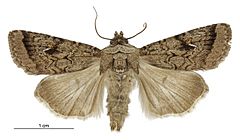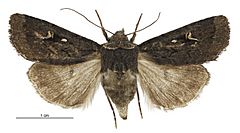Proteuxoa comma facts for kids
Quick facts for kids Proteuxoa comma |
|
|---|---|
 |
|
| Male | |
 |
|
| Female | |
| Scientific classification | |
| Kingdom: | |
| Phylum: | |
| Class: | |
| Order: | |
| Family: | |
| Genus: |
Proteuxoa
|
| Species: |
P. comma
|
| Binomial name | |
| Proteuxoa comma (Walker, 1856)
|
|
| Synonyms | |
|
|
The Proteuxoa comma is a type of moth that belongs to the Noctuidae family. This means it's related to many other moths, including some that are active at night. This special moth is found only in New Zealand. It looks quite a lot like another moth called P. tetronycha.
Contents
Discovering the Proteuxoa comma
This moth was first described by a scientist named Francis Walker in 1856. When he first found it, he gave it the name Mamestra comma. Scientists often change names as they learn more about different species.
What the Proteuxoa comma Looks Like
The Proteuxoa comma moth is mostly a greyish color. Its head might be a bit lighter, almost whitish. The front wings are often sprinkled with brown spots. They also have wavy or zigzag lines across them. The back wings are usually lighter, especially near the body.
It can be a bit tricky to tell the Proteuxoa comma apart from its close relative, P. tetronycha. However, there are a few clues! The Proteuxoa comma has a less noticeable collar around its neck area. Its front wings are also more grey. Plus, its wings look a bit narrower.
Another way to tell them apart is by size. The Proteuxoa comma is usually a little bigger. If a moth has a wingspan (the distance from one wingtip to the other) of more than 33 millimeters, it's likely a Proteuxoa comma.
Where the Proteuxoa comma Lives
This moth is endemic to New Zealand. This means you won't find it naturally anywhere else in the world! It's a unique part of New Zealand's amazing wildlife.
Images for kids


